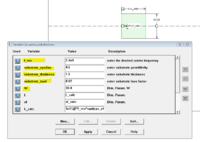Hana Rashid
Newbie level 5

- Joined
- Jun 18, 2014
- Messages
- 10
- Helped
- 0
- Reputation
- 0
- Reaction score
- 0
- Trophy points
- 1
- Activity points
- 84
Hi all,
Need your tips n advise on my design.
It is a 2.4GHz rectangular patch antenna, inset feed, FR-4 of er=4.3 and loss tangent 0.02. Simulate using CST MWR.
It shows double resonant in the S-11 parameter.
How does this happen? Is something wrong with my design? Which part of it that gets wrong?
What cause this to happen?
I don't know. Please help. Is there anywhere I could read about this? Any papers/books?
N which parameter I should adjust to get rid of those unwanted resonant?
I only want it to be at 2.4GHz.
the design, paramaters and s-11 are attached.
Thanks in advance.
Need your tips n advise on my design.
It is a 2.4GHz rectangular patch antenna, inset feed, FR-4 of er=4.3 and loss tangent 0.02. Simulate using CST MWR.
It shows double resonant in the S-11 parameter.
How does this happen? Is something wrong with my design? Which part of it that gets wrong?
What cause this to happen?
I don't know. Please help. Is there anywhere I could read about this? Any papers/books?
N which parameter I should adjust to get rid of those unwanted resonant?
I only want it to be at 2.4GHz.
the design, paramaters and s-11 are attached.
Thanks in advance.









